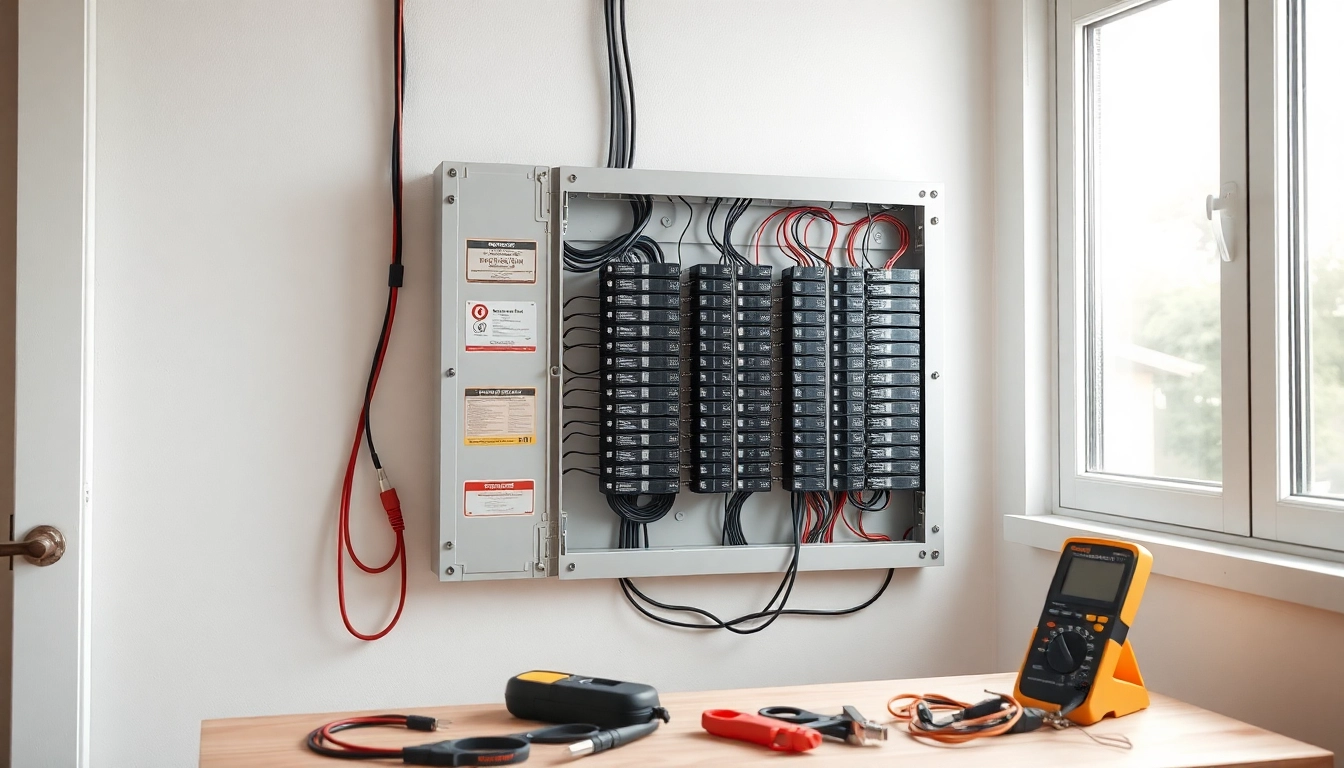A Comprehensive Overview of Electrical Panels
In every household, the electrical panel (also known as the breaker box or service panel) plays a crucial role in ensuring that your home receives power in a safe and efficient manner. As the heart of your electrical system, it manages the flow of electricity to various outlets and devices, protecting them from overloads. Understanding its functions, types, and components is essential for homeowners who want to maintain a safe and efficient electrical system. For a comprehensive guide on when to upgrade your electrical panel, you can explore this Electrical Panel resource.
Understanding the Function of Electrical Panels
The primary function of an electrical panel is to serve as the main hub for electricity distribution within a home. It receives electrical power from the utility service and distributes it through individual circuits, each protected by a circuit breaker. These circuit breakers are designed to prevent electrical overloads, which can lead to dangerous situations such as fires or blown fuses.
Additionally, electrical panels allow for the safe and efficient management of electrical power. They include a main switch which can disconnect all power at once, enabling quick action in emergencies. Furthermore, modern panels may also provide advanced features such as surge protection, ensuring that sensitive electronic devices are shielded from power spikes.
Types of Electrical Panels and Their Features
Understanding the different types of electrical panels available can help homeowners make informed decisions when it comes to installation or upgrades. Here are the primary types of electrical panels:
- Standard Breaker Panels: These are the most commonly found panels in residential homes. They have circuit breakers that are resettable and designed to protect household circuits.
- Subpanels: Subpanels are smaller panels that provide distribution of electricity to specific areas or large appliances. They are commonly used in larger homes or where additional capacity is needed.
- Smart Panels: These modern panels provide advanced capabilities, often including remote monitoring and control, energy usage statistics, and integration with home automation systems.
- Fused Panels: Less common in modern homes, fused panels use fuses instead of breakers. They are typically found in older homes and require the replacement of fuses instead of resetting breakers.
Key Components of an Electrical Panel
Every electrical panel contains several key components that work together to ensure safe electricity distribution:
- Main Breaker: The main breaker controls the power supply to the entire home and may be shut off in emergencies.
- Circuit Breakers: These devices automatically shut off electrical flow in case of overloads, preventing potential damage and fire hazards.
- Bus Bar: This metal strip conducts electricity from the main breaker to the individual circuit breakers.
- Grounding System: Essential for safety, the grounding system protects against electrical surges and helps prevent electrical shocks.
- Neutral Bar: This component is responsible for returning the electrical current back to the main service line.
Signs You Need to Upgrade Your Electrical Panel
Recognizing when your electrical panel may need an upgrade is crucial to maintaining a safe and functional home. Several indicators can suggest that it’s time to invest in an upgraded panel.
Common Indicators of Electrical Panel Issues
There are various signs that can indicate problems with your electrical panel:
- Frequent Breaker Trips: If your circuit breakers are frequently tripping, this may indicate that your panel is overloaded or failing.
- Burning Smell: A burning smell coming from the panel or outlets can be a serious sign of electrical issues, highlighting wire overheating.
- Damaged or Discolored Breakers: Any signs of wear and tear, damage, or discoloration on the breakers can indicate malfunction and should be inspected immediately.
- Buzzing Sounds: If you hear a buzzing sound emanating from your panel, it could indicate an electrical issue that needs to be evaluated.
Your Electrical Usage Trends and Capacity
As households grow and the number of electronic devices increases, so does power demand. An outdated electrical panel may not be equipped to handle the increased load. Evaluating your electrical usage trends can help assess whether your panel is sufficient. If you find that your energy consumption is consistently pushing the limits of your current capacity, an upgrade may be necessary.
Safety Risks of an Outdated Electrical Panel
An outdated electrical panel can pose significant safety risks beyond capacity issues. Older panels may not have the necessary safeguards against power surges or overloads, leaving your home vulnerable to electrical fires and shocks. Additionally, the corrosion or damage within an older panel can lead to dangerous short circuits. It’s essential to prioritize safety by considering an upgrade if your panel is older than 25 years or exhibiting any of the warning signs mentioned earlier.
The Process of Upgrading an Electrical Panel
Upgrading your electrical panel is a significant decision and requires careful planning and execution. Here’s a detailed look at the steps involved in this process.
Pre-Upgrade Assessment and Planning
Before upgrading your electrical panel, a thorough assessment is critical. This usually involves a professional electrician evaluating your current electrical system and load requirements:
- Load Calculation: An electrician will compute the expected loads to determine the appropriate size for your new panel, ensuring it meets your current and future electrical demands.
- Inspection of Existing Wiring: An evaluation of your home’s existing wiring setup is crucial. In some cases, the wiring might also need updating to accommodate the new panel.
- Permitting and Compliance: Ensure to check local building codes and obtain the necessary permits for the upgrade. Compliance with these regulations is crucial for safety and legality.
Steps Involved in Electrical Panel Replacement
The actual replacement of an electrical panel involves several important steps:
- Power Shutdown: The first step is to turn off the power supply to the existing panel.
- Removing the Old Panel: Carefully disconnecting and removing the old panel must be done meticulously to avoid damaging any connected circuits.
- Installing the New Panel: The new panel is then installed, ensuring all connections are secure and compliant with electrical codes.
- Testing: After installation, all circuits should be tested to ensure everything is functioning correctly.
- Final Inspection: It’s often required to have a final inspection by a local authority to ensure everything complies with safety standards.
Working with Certified Electricians
With the complexity and hazards associated with electrical work, it’s crucial to hire certified electricians for the upgrade process. Qualified professionals bring expertise in ensuring that your electrical system is safe, reliable, and compliant with all codes and standards. They can also provide valuable advice regarding the best panel types for your specific needs and preferences.
Choosing the Right Electrical Panel for Your Home
When it’s time to select a new electrical panel, consider various factors that ensure you choose the right option for your home.
Evaluating Electrical Panel Specifications
Different electrical panels come with various specifications. Key aspects to evaluate include:
- Amperage Rating: Common ratings for residential panels are 100, 200, or even 400 amps. Choosing the right rating ensures that your panel can handle all your electrical demands.
- Breakers: Review the number and type of breakers included with the panel. Ensure it has enough space for potential future upgrades.
- Surge Protection: Considering panels with built-in surge protection can help shield your electronics from damages due to power surges.
Comparing Popular Brands and Models
There are several brands and models available, each with its unique features and reputation. Research highly regarded options such as Square D, Siemens, and Eaton. Look for products with positive reviews that highlight their reliability and performance. Consulting with your electrician can also provide insights into what brands work best in your area, particularly concerning local electrical infrastructure.
Cost Considerations and Budgeting for Upgrades
Upgrading an electrical panel can be a considerable investment, depending on factors such as capacity, brand, labor costs, and additional improvements needed, such as wiring updates. On average, costs can range from $1,000 to $3,000 for a full upgrade.
When budgeting, it’s essential to include not only the cost of the panel and installation but also contingency funds for unforeseen circumstances. As an investment in safety and efficiency, budgeting correctly for an electrical panel upgrade is both prudent and necessary.
Maintenance Tips for Electrical Panels
Once your electrical panel is upgraded, its longevity and functionality depend significantly on proper maintenance. Here are some practical tips to ensure safe and continued operation:
Regular Checks to Ensure Safe Operation
Conducting regular visual inspections of your electrical panel can identify problems before they escalate. Look for:
- Signs of overheating, such as discoloration around breakers.
- Dust accumulation, which can impact the efficiency of the panel.
- Loose connections that may cause electrical arcs.
When to Seek Professional Maintenance
If you notice any of the warning signs mentioned earlier – such as burning smells or buzzing sounds – seeking a professional electrician’s help is vital. Additionally, consider scheduling professional inspections every few years to ensure ongoing safety and compliance.
Enhancing Your Panel’s Longevity with Good Practices
Implementing good practices can extend the operational life of your electrical panel:
- Limit Overloading: Ensure that you are not overloading any circuit by distributing your electrical devices across multiple outlets.
- Don’t Ignore Changes: If you start adding significant electrical loads, consider consulting with an electrician on whether your panel can handle the additional demands.
- Keep It Dry: Ensure your electrical panel is kept dry and well-ventilated to prevent rust and corrosion.


